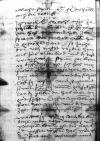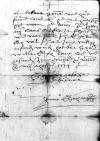Ich hab E(wer) G(nad)e mer malle(n), saÿd ich in ⌊Spanÿa(m)⌋ kome(n) pein(n), geschribe(n) und dona ⌊Iuanÿca⌋ halbe(n) mein(e) maÿno(n)g und gut bedonck(en) anzaig(e)t, ouch d(a)z selb montlich mÿt dem ⌊electus vo(n) Lunda⌋ geret. D(a)z ⌊thochterle⌋ facht an, gros werd(en), und yst zÿt, d(a)z mans vo(n) der ⌊mutter⌋ neme. So mag E(wer) G(nade) die ⌊mutter⌋ mÿt 150 in 200 duc(aten) zu frÿden stelle(n) uff ain(n) mal. Da mÿt wuÿrt ⌊sÿ⌋ irrn remedio suche(n). So mocht d(a)z ⌊tochterle⌋ E(wer) G(nade) etwa in geselschafft erlicher frowe(n) und luÿt, so teglich ins ⌊Nÿderland⌋ fare(n), da hein gesant werd(en). Das rant ich E(wer) G(nad)e als ain(n) trüewer superinscribed⌈rr superinscribed⌉, gutter gefather, dan es kan nÿt minder(e) sein(n). Die kinder musse(n)d gelt cost(en), das waÿs ich peÿ mier(e) selbs. So ma(n) die arbaÿt nÿmpt, die zu mache(n), so mus ma(n) nach mals geduldt habe(n), den seckel uff ze thun.  AAWO, AB, D. 91, f. 174vr ⌊Albrecht⌋ ⌊⌋ E(wer) G(naden) deshalbe(n) ouch die nottorfft.
AAWO, AB, D. 91, f. 174vr ⌊Albrecht⌋ ⌊⌋ E(wer) G(naden) deshalbe(n) ouch die nottorfft.
Ich waÿs E(wer) G(nad)e nÿchs nuÿes ze schribe(n). Der ⌊kaÿsser⌋ ÿst zu ⌊Palencz⌋, der hoff hern und her zer spraÿt, des sterbend halbe(n), hie a(n) gefange(n) hant. / So zuÿcht ⌊der von Nassov⌋ wÿder hein aus ins ⌊Nÿder(e)land⌋ und d(a)z vast wenÿg tuÿsch, schier(e) gar kaÿner an dÿsse(n) hoff ÿst. Ich hab mein ⌊frowe(n)⌋, E(wer) G(nad)e gefather, hie peÿ mier(e). Ire wil die selczame(n) loff in unsern land(en) regierend, so wil ich im name(n) goz in dÿsse(n) land(en) plibe(n). Da hab wier(e) ain(n) gut, sÿcher, crÿstenlich lebe(n). Got der her welle uns d(a)z lange zÿt mÿt gnad(en) v(er)liche(n).
Wie das in unssern ⌊land(en)⌋ der krieg dorch ander nazio(n) anrÿcht(en) und platique(n) kome(n) ÿst, des mag E(wer) G(nad)e pesser wÿsse(n). Hab(en) wier wd(?) ain(e) fart ouch gestraufft, werd(en)  AAWO, AB, D. 91, f. 175r al bekant herre(n) und gut fre superinscribed⌈ee superinscribed⌉ und lond E(wer) G(nad)e vi(e)l gutzs sage(n). Pÿt Euwer G(nad)e im(m)er zu zÿtten ain(n) clains brieffle ze schribe(n), und war inne(n) ich E(wer) G(nad)e diene(n) kan, wil ich al zeÿt willÿg erfond(en) werd(en). Got der her welle E(wer) G(nade) lang leb(en) und gesund(en) zÿt v(er)liche(n).
AAWO, AB, D. 91, f. 175r al bekant herre(n) und gut fre superinscribed⌈ee superinscribed⌉ und lond E(wer) G(nad)e vi(e)l gutzs sage(n). Pÿt Euwer G(nad)e im(m)er zu zÿtten ain(n) clains brieffle ze schribe(n), und war inne(n) ich E(wer) G(nad)e diene(n) kan, wil ich al zeÿt willÿg erfond(en) werd(en). Got der her welle E(wer) G(nade) lang leb(en) und gesund(en) zÿt v(er)liche(n).
 AAWO, AB, D. 91, f. 174vr
AAWO, AB, D. 91, f. 174vr  AAWO, AB, D. 91, f. 175r al bekant herre(n) und gut fre superinscribed⌈ee superinscribed⌉ und lond E(wer) G(nad)e vi(e)l gutzs sage(n). Pÿt Euwer G(nad)e im(m)er zu zÿtten ain(n) clains brieffle ze schribe(n), und war inne(n) ich E(wer) G(nad)e diene(n) kan, wil ich al zeÿt willÿg erfond(en) werd(en). Got der her welle E(wer) G(nade) lang leb(en) und gesund(en) zÿt v(er)liche(n).
AAWO, AB, D. 91, f. 175r al bekant herre(n) und gut fre superinscribed⌈ee superinscribed⌉ und lond E(wer) G(nad)e vi(e)l gutzs sage(n). Pÿt Euwer G(nad)e im(m)er zu zÿtten ain(n) clains brieffle ze schribe(n), und war inne(n) ich E(wer) G(nad)e diene(n) kan, wil ich al zeÿt willÿg erfond(en) werd(en). Got der her welle E(wer) G(nade) lang leb(en) und gesund(en) zÿt v(er)liche(n).



